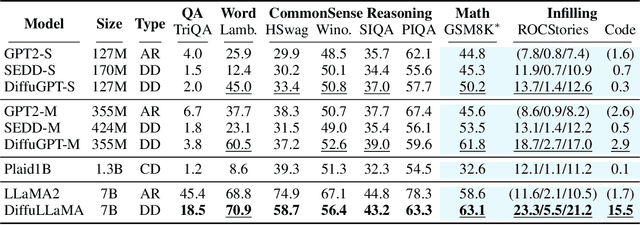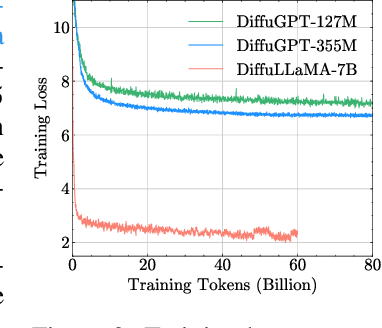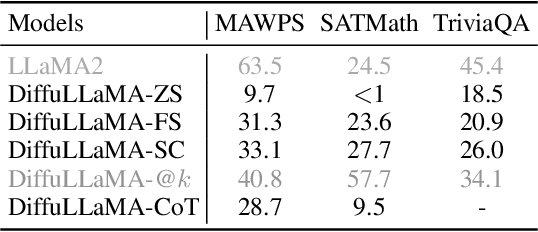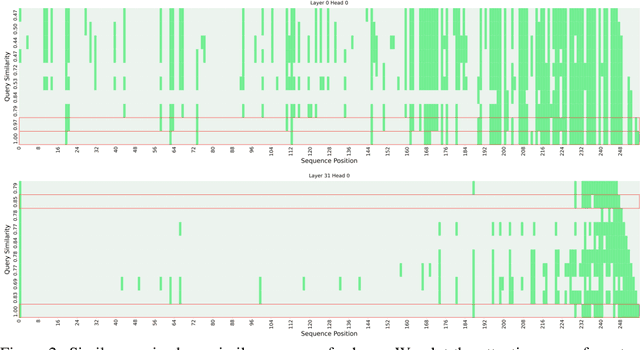Wei Bi
SeqPE: Transformer with Sequential Position Encoding
Jun 16, 2025Abstract:Since self-attention layers in Transformers are permutation invariant by design, positional encodings must be explicitly incorporated to enable spatial understanding. However, fixed-size lookup tables used in traditional learnable position embeddings (PEs) limit extrapolation capabilities beyond pre-trained sequence lengths. Expert-designed methods such as ALiBi and RoPE, mitigate this limitation but demand extensive modifications for adapting to new modalities, underscoring fundamental challenges in adaptability and scalability. In this work, we present SeqPE, a unified and fully learnable position encoding framework that represents each $n$-dimensional position index as a symbolic sequence and employs a lightweight sequential position encoder to learn their embeddings in an end-to-end manner. To regularize SeqPE's embedding space, we introduce two complementary objectives: a contrastive objective that aligns embedding distances with a predefined position-distance function, and a knowledge distillation loss that anchors out-of-distribution position embeddings to in-distribution teacher representations, further enhancing extrapolation performance. Experiments across language modeling, long-context question answering, and 2D image classification demonstrate that SeqPE not only surpasses strong baselines in perplexity, exact match (EM), and accuracy--particularly under context length extrapolation--but also enables seamless generalization to multi-dimensional inputs without requiring manual architectural redesign. We release our code, data, and checkpoints at https://github.com/ghrua/seqpe.
Unlocking Multimodal Integration in EHRs: A Prompt Learning Framework for Language and Time Series Fusion
Feb 19, 2025Abstract:Large language models (LLMs) have shown remarkable performance in vision-language tasks, but their application in the medical field remains underexplored, particularly for integrating structured time series data with unstructured clinical notes. In clinical practice, dynamic time series data such as lab test results capture critical temporal patterns, while clinical notes provide rich semantic context. Merging these modalities is challenging due to the inherent differences between continuous signals and discrete text. To bridge this gap, we introduce ProMedTS, a novel self-supervised multimodal framework that employs prompt-guided learning to unify these heterogeneous data types. Our approach leverages lightweight anomaly detection to generate anomaly captions that serve as prompts, guiding the encoding of raw time series data into informative embeddings. These embeddings are aligned with textual representations in a shared latent space, preserving fine-grained temporal nuances alongside semantic insights. Furthermore, our framework incorporates tailored self-supervised objectives to enhance both intra- and inter-modal alignment. We evaluate ProMedTS on disease diagnosis tasks using real-world datasets, and the results demonstrate that our method consistently outperforms state-of-the-art approaches.
Generative Visual Commonsense Answering and Explaining with Generative Scene Graph Constructing
Jan 15, 2025Abstract:Visual Commonsense Reasoning, which is regarded as one challenging task to pursue advanced visual scene comprehension, has been used to diagnose the reasoning ability of AI systems. However, reliable reasoning requires a good grasp of the scene's details. Existing work fails to effectively exploit the real-world object relationship information present within the scene, and instead overly relies on knowledge from training memory. Based on these observations, we propose a novel scene-graph-enhanced visual commonsense reasoning generation method named \textit{\textbf{G2}}, which first utilizes the image patches and LLMs to construct a location-free scene graph, and then answer and explain based on the scene graph's information. We also propose automatic scene graph filtering and selection strategies to absorb valuable scene graph information during training. Extensive experiments are conducted on the tasks and datasets of scene graph constructing and visual commonsense answering and explaining, respectively. Experimental results and ablation analysis demonstrate the effectiveness of our proposed framework.
Scaling Diffusion Language Models via Adaptation from Autoregressive Models
Oct 23, 2024



Abstract:Diffusion Language Models (DLMs) have emerged as a promising new paradigm for text generative modeling, potentially addressing limitations of autoregressive (AR) models. However, current DLMs have been studied at a smaller scale compared to their AR counterparts and lack fair comparison on language modeling benchmarks. Additionally, training diffusion models from scratch at scale remains challenging. Given the prevalence of open-source AR language models, we propose adapting these models to build text diffusion models. We demonstrate connections between AR and diffusion modeling objectives and introduce a simple continual pre-training approach for training diffusion models. Through systematic evaluation on language modeling, reasoning, and commonsense benchmarks, we show that we can convert AR models ranging from 127M to 7B parameters (GPT2 and LLaMA) into diffusion models DiffuGPT and DiffuLLaMA, using less than 200B tokens for training. Our experimental results reveal that these models outperform earlier DLMs and are competitive with their AR counterparts. We release a suite of DLMs (with 127M, 355M, and 7B parameters) capable of generating fluent text, performing in-context learning, filling in the middle without prompt re-ordering, and following instructions \url{https://github.com/HKUNLP/DiffuLLaMA}.
Gated Slot Attention for Efficient Linear-Time Sequence Modeling
Sep 11, 2024



Abstract:Linear attention Transformers and their gated variants, celebrated for enabling parallel training and efficient recurrent inference, still fall short in recall-intensive tasks compared to traditional Transformers and demand significant resources for training from scratch. This paper introduces Gated Slot Attention (GSA), which enhances Attention with Bounded-memory-Control (ABC) by incorporating a gating mechanism inspired by Gated Linear Attention (GLA). Essentially, GSA comprises a two-layer GLA linked via softmax, utilizing context-aware memory reading and adaptive forgetting to improve memory capacity while maintaining compact recurrent state size. This design greatly enhances both training and inference efficiency through GLA's hardware-efficient training algorithm and reduced state size. Additionally, retaining the softmax operation is particularly beneficial in "finetuning pretrained Transformers to RNNs" (T2R) settings, reducing the need for extensive training from scratch. Extensive experiments confirm GSA's superior performance in scenarios requiring in-context recall and in T2R settings.
Rethinking Targeted Adversarial Attacks For Neural Machine Translation
Jul 07, 2024



Abstract:Targeted adversarial attacks are widely used to evaluate the robustness of neural machine translation systems. Unfortunately, this paper first identifies a critical issue in the existing settings of NMT targeted adversarial attacks, where their attacking results are largely overestimated. To this end, this paper presents a new setting for NMT targeted adversarial attacks that could lead to reliable attacking results. Under the new setting, it then proposes a Targeted Word Gradient adversarial Attack (TWGA) method to craft adversarial examples. Experimental results demonstrate that our proposed setting could provide faithful attacking results for targeted adversarial attacks on NMT systems, and the proposed TWGA method can effectively attack such victim NMT systems. In-depth analyses on a large-scale dataset further illustrate some valuable findings. 1 Our code and data are available at https://github.com/wujunjie1998/TWGA.
Spotting AI's Touch: Identifying LLM-Paraphrased Spans in Text
May 21, 2024



Abstract:AI-generated text detection has attracted increasing attention as powerful language models approach human-level generation. Limited work is devoted to detecting (partially) AI-paraphrased texts. However, AI paraphrasing is commonly employed in various application scenarios for text refinement and diversity. To this end, we propose a novel detection framework, paraphrased text span detection (PTD), aiming to identify paraphrased text spans within a text. Different from text-level detection, PTD takes in the full text and assigns each of the sentences with a score indicating the paraphrasing degree. We construct a dedicated dataset, PASTED, for paraphrased text span detection. Both in-distribution and out-of-distribution results demonstrate the effectiveness of PTD models in identifying AI-paraphrased text spans. Statistical and model analysis explains the crucial role of the surrounding context of the paraphrased text spans. Extensive experiments show that PTD models can generalize to versatile paraphrasing prompts and multiple paraphrased text spans. We release our resources at https://github.com/Linzwcs/PASTED.
Sequence can Secretly Tell You What to Discard
Apr 24, 2024



Abstract:Large Language Models (LLMs), despite their impressive performance on a wide range of tasks, require significant GPU memory and consume substantial computational resources. In addition to model weights, the memory occupied by KV cache increases linearly with sequence length, becoming a main bottleneck for inference. In this paper, we introduce a novel approach for optimizing the KV cache which significantly reduces its memory footprint. Through a comprehensive investigation, we find that on LLaMA2 series models, (i) the similarity between adjacent tokens' query vectors is remarkably high, and (ii) current query's attention calculation can rely solely on the attention information of a small portion of the preceding queries. Based on these observations, we propose CORM, a KV cache eviction policy that dynamically retains important key-value pairs for inference without finetuning the model. We validate that CORM reduces the inference memory usage of KV cache by up to 70% without noticeable performance degradation across six tasks in LongBench.
DECIDER: A Rule-Controllable Decoding Strategy for Language Generation by Imitating Dual-System Cognitive Theory
Mar 04, 2024Abstract:Lexicon-based constrained decoding approaches aim to control the meaning or style of the generated text through certain target concepts. Existing approaches over-focus the targets themselves, leading to a lack of high-level reasoning about how to achieve them. However, human usually tackles tasks by following certain rules that not only focuses on the targets but also on semantically relevant concepts that induce the occurrence of targets. In this work, we present DECIDER, a rule-controllable decoding strategy for constrained language generation inspired by dual-system cognitive theory. Specifically, in DECIDER, a pre-trained language model (PLM) is equiped with a logic reasoner that takes high-level rules as input. Then, the DECIDER allows rule signals to flow into the PLM at each decoding step. Extensive experimental results demonstrate that DECIDER can effectively follow given rules to guide generation direction toward the targets in a more human-like manner.
FuseChat: Knowledge Fusion of Chat Models
Mar 03, 2024Abstract:While training large language models (LLMs) from scratch can indeed lead to models with distinct capabilities and strengths, this approach incurs substantial costs and may lead to potential redundancy in competencies. An alternative strategy is to combine existing LLMs into a more robust LLM, thereby diminishing the necessity for expensive pre-training. However, due to the diverse architectures of LLMs, direct parameter blending proves to be unfeasible. Recently, \textsc{FuseLLM} introduced the concept of knowledge fusion to transfer the collective knowledge of multiple structurally varied LLMs into a target LLM through lightweight continual training. In this report, we extend the scalability and flexibility of the \textsc{FuseLLM} framework to realize the fusion of chat LLMs, resulting in \textsc{FuseChat}. \textsc{FuseChat} comprises two main stages. Firstly, we undertake knowledge fusion for structurally and scale-varied source LLMs to derive multiple target LLMs of identical structure and size via lightweight fine-tuning. Then, these target LLMs are merged within the parameter space, wherein we propose a novel method for determining the merging weights based on the variation ratio of parameter matrices before and after fine-tuning. We validate our approach using three prominent chat LLMs with diverse architectures and scales, namely \texttt{NH2-Mixtral-8x7B}, \texttt{NH2-Solar-10.7B}, and \texttt{OpenChat-3.5-7B}. Experimental results spanning various chat domains demonstrate the superiority of \texttt{\textsc{FuseChat}-7B} across a broad spectrum of chat LLMs at 7B and 34B scales, even surpassing \texttt{GPT-3.5 (March)} and approaching \texttt{Mixtral-8x7B-Instruct}. Our code, model weights, and data are openly accessible at \url{https://github.com/fanqiwan/FuseLLM}.
 Add to Chrome
Add to Chrome Add to Firefox
Add to Firefox Add to Edge
Add to Edge